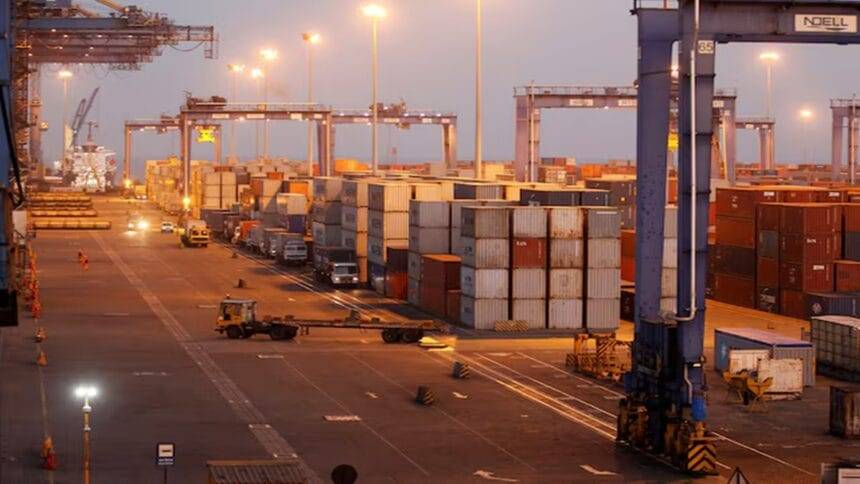Main Points In Hindi (मुख्य बातें – हिंदी में)
-
भारत के व्यापार समझौतों की समीक्षा: भारत के 14 देशों या आर्थिक ब्लॉकों के साथ द्विपक्षीय व्यापार समझौते हैं, जिनमें से चार प्रमुख समझौतों को समीक्षा या सुधार के लिए फिर से विचारित किया जा रहा है।
-
यूएई के साथ सीईपीए का संकट: भारत और यूएई के बीच हाल के व्यापक आर्थिक साझेदारी समझौते (CEPA) में व्यापार के संदर्भ में उत्पत्ति के नियमों के उल्लंघन का खतरा है, जिसके कारण भारत ने अधिक निगरानी की मांग की है।
-
आयात पर प्रभाव: पिछले 18 महीनों में भारत की सोने और चांदी के आयात में उल्लेखनीय वृद्धि हुई है, जिसका सीधा प्रभाव सरकारी राजस्व और घरेलू उद्योग पर पड़ा है। यूएई से चांदी का आयात 5,853% और सोने के आभूषण का आयात 290% बढ़ा है।
-
भविष्य की चुनौतियाँ: भारत को अपने अधिकार क्षेत्र के तहत किए गए शुल्क रियायतों की समीक्षा करनी होगी, क्योंकि इससे घरेलू उद्योग की सुरक्षा पर प्रभाव पड़ सकता है। विशेषकर, हीरा व्यापार में शून्य शुल्क का प्रावधान चिंता का विषय है।
- गैर-टैरिफ बाधाएँ और व्यापार संतुलन: विशेषज्ञों के अनुसार, भारत को एफटीए से अपेक्षित लाभ नहीं मिल पा रहा है, और गैर-टैरिफ बाधाएं व्यापार के लिए एक महत्वपूर्ण चुनौती बन गई हैं, जिनमें मानकों का अनुपालन और जटिल प्रक्रियाएँ शामिल हैं।
Main Points In English(मुख्य बातें – अंग्रेज़ी में)
Here are the main points from the provided text:
-
Bilateral Trade Agreements Under Review: India has bilateral trade agreements with 14 countries or economic blocks, but four significant agreements are currently under review or require revision due to shortcomings in their implementation and benefits.
-
Impact of Recent Agreements: The India-UAE Comprehensive Economic Partnership Agreement (CEPA) has led to a significant increase in imports of gold and silver from the UAE, raising concerns about how effectively the agreement’s terms are being followed, particularly regarding the rules of origin.
-
Challenges and Dependence on Tariff Concessions: While tariff concessions have been granted, the actual benefits to India from these agreements have been limited, partly due to non-tariff barriers and stringent compliance requirements set by partner countries like Japan and South Korea.
-
Trade Deficits and Critiques: Despite entering these free trade agreements (FTAs), India has experienced increasing trade deficits with several countries, indicating that the expected benefits have not materialized as hoped.
- Need for Policy Adjustments: Experts argue for the need to reassess and potentially revise tariff concessions and compliance rules to enhance India’s competitive edge in international trade, ensuring better alignment between India’s exports and the regulatory landscapes of its trade partners.


Complete News In Hindi(पूरी खबर – हिंदी में)
जबकि भारत के 14 देशों या आर्थिक ब्लॉकों के साथ द्विपक्षीय व्यापार समझौते हैं, इनमें से चार सबसे महत्वपूर्ण समझौते समीक्षा या सुधार के लिए वापस ड्राइंग बोर्ड में चले गए हैं।
यहां तक कि संयुक्त अरब अमीरात के साथ अपेक्षाकृत हालिया समझौते की भी समीक्षा की जा रही है भारतइनमें से कम से कम कुछ समझौतों को अंतिम रूप दिए जाने से पहले पर्याप्त विवरण की कमी को दर्शाता है।
कुछ मामलों में, इन समझौतों के क्रियान्वयन से यह स्पष्ट हो गया कि भागीदार देशों ने व्यापार के संदर्भ में अधिकांश लाभ रियायती शर्तों पर ले लिए।
उदाहरण के लिए, भारत-यूएई व्यापक आर्थिक साझेदारी समझौता (सीईपीए) लागू होने के बाद से पिछले 18 महीनों में सोने के आयात में तेज वृद्धि हुई है। चाँदी और दुबई से आभूषण, सरकारी राजस्व और घरेलू पर प्रभाव डाल रहे हैं उद्योग.
समीक्षा के बिना, नुकसान काफी बड़ा होता, लेकिन इस महीने की शुरुआत में सीईपीए के तहत संयुक्त समिति की बैठक में, संयुक्त अरब अमीरात ने यह सुनिश्चित करने के लिए अधिक निगरानी रखने के भारत के अनुरोध पर सहमति व्यक्त की कि उत्पत्ति के नियमों को दरकिनार नहीं किया जाए।
यूएई के साथ समझौते में अगले कुछ वर्षों में भारत में शुल्क मुक्त सोना, चांदी, प्लैटिनम और हीरे के असीमित आयात का प्रावधान है। समझौते के पहले वर्ष में, संयुक्त अरब अमीरात से चांदी का आयात नाटकीय रूप से 5,853% बढ़ गया, जो वित्त वर्ष 2023 में 29.2 मिलियन डॉलर से बढ़कर वित्त वर्ष 2024 में 1.74 बिलियन डॉलर हो गया। यूएई से सोने के आभूषणों का आयात 290% बढ़ गया, जो वित्त वर्ष 2023 में 347 मिलियन डॉलर से बढ़कर वित्त वर्ष 2024 में 1.35 बिलियन डॉलर हो गया।
चूंकि यूएई सोने या चांदी का उत्पादक नहीं है, इसलिए अधिकांश निर्यात उत्पत्ति के नियमों के उदार अनुप्रयोग द्वारा संभव हुआ। ग्लोबल ट्रेड रिसर्च इनिशिएटिव (जीटीआरआई) के संस्थापक अजय श्रीवास्तव के अनुसार, हालांकि भारत ने यूएई को दी जाने वाली रियायतों में कोई संशोधन नहीं मांगा है, लेकिन समझौते में हीरा व्यापार के मुद्दे को अनसुलझा छोड़ दिया गया है।
भारत कटे और पॉलिश किए गए हीरों पर 5% शुल्क और कच्चे हीरे पर 0% शुल्क लगाता है। आने वाले वर्षों में हीरे पर शून्य शुल्क घरेलू उद्योग को मिलने वाली सुरक्षा को छीन लेगा। यदि ध्यान न दिया गया तो यह मुद्दा बाद में सामने आएगा।
भारत ने 2009 में एफटीए खेल में प्रवेश किया जब उसने दक्षिण कोरिया के साथ सीईपीए और एसोसिएशन ऑफ साउथईस्ट एशियन नेशंस (आसियान) के साथ एफटीए पर हस्ताक्षर किए। 2011 में, जापान के साथ CEPA द्वारा इसका अनुसरण किया गया। तीनों समझौतों की अब व्यापक समीक्षा हो रही है क्योंकि भारत को लगा कि उसे अपने संधि भागीदारों की तुलना में कम लाभ हुआ है।
उनके कारण होने वाली तमाम तकलीफों के बावजूद, एफटीए को हटाया नहीं जा सकता क्योंकि बहुत कुछ दांव पर लगा हुआ है। वर्तमान में, भारत के व्यापार समझौतों में 26 देश शामिल हैं। अब यह यूके, यूरोपीय संघ, पेरू और ओमान सहित 45 देशों के साथ नए एफटीए पर बातचीत कर रहा है। इससे भारत के निर्यात का एक बड़ा हिस्सा एमएफएन मार्ग से तरजीही मार्ग पर चला जाएगा।
आसियान के साथ माल व्यापार पर समझौते के सक्रिय होने के पांच साल के भीतर, भारत ने समझौते की समीक्षा के लिए पूछना शुरू कर दिया था और समीक्षा के दायरे पर पहली बार 2015 में चर्चा की गई थी। वर्षों की बातचीत के बाद, आसियान अंततः 2019 में समीक्षा के लिए सहमत हुआ। 2022 तक समीक्षा का दायरा बढ़ाने पर सहमति बनी. अब, दोनों पक्ष समीक्षा पूरी करने के लिए 2025 की समय सीमा के साथ काम कर रहे हैं।
कोरिया के साथ, भारत को 93.2% टैरिफ लाइनों पर टैरिफ उन्मूलन या रियायतें मिलीं, जबकि 83.8% टैरिफ लाइनों पर कम शुल्क स्वीकार किया गया। यहां तक कि सीईपीए लागू होने के बाद से दक्षिण कोरिया के साथ भारत के व्यापार घाटे को 220% बढ़ने से नहीं रोका जा सका, जबकि शेष दुनिया के साथ इसका व्यापार घाटा 132.2% था। जापान के साथ घाटा लगभग 140% बढ़ गया है, जो औसत वृद्धि के अनुरूप है।
आसियान के साथ, निर्यात में 123.9% और आयात में 175.7% की वृद्धि हुई; जापान के साथ, निर्यात में 56.4% और आयात में 98.5% की वृद्धि हुई; और दक्षिण कोरिया के साथ, व्यापार समझौते के बाद निर्यात में 89.1% और आयात में 127.3% की वृद्धि हुई। इस प्रकार के डेटा के साथ, आसियान और कोरिया के साथ समीक्षा की आवश्यकता अधिक हो जाती है। आसियान और कोरिया के साथ बातचीत लगातार जारी है. जापान के साथ अभी गति पकड़नी बाकी है।
विशेषज्ञों के अनुसार, भारत को इन एफटीए से अधिक लाभ नहीं मिल सका क्योंकि पूर्ण रूप से इसकी टैरिफ रियायतें उसके साझेदारों की तुलना में अधिक गहरी थीं, जिनके पास पहले से ही कम टैरिफ थे। इसलिए, आसियान, कोरिया और जापान से निर्यात को अधिक बढ़ावा मिला। भारत का निर्यात इच्छानुसार नहीं बढ़ने का एक बड़ा कारण यह है कि कोरिया और जापान कड़े मानक, नियम और प्रमाणन आवश्यकताएँ लागू करते हैं। इन मानकों के अनुरूप होना और फिर प्रमाणपत्र प्राप्त करना महंगा है, जिससे कई निर्यातक बाहर रहते हैं। कुछ अनुमानों के अनुसार, भारत द्वारा एफटीए रियायतों का उपयोग विकसित देशों द्वारा 70-80% की तुलना में केवल 25% है।
श्रीवास्तव ने कहा कि कई भारतीय कंपनियां आयात शुल्क कम होने पर एफटीए मार्ग का उपयोग नहीं करने का विकल्प चुनती हैं, क्योंकि एफटीए से संबंधित अनुपालन लागत टैरिफ लाभों को उचित नहीं ठहराती है जो पहले से ही कम हैं।
जापान, आसियान और कोरिया एफटीए दोनों की समीक्षा में प्रमुख मुद्दों में से एक मानकों के अनुपालन को आसान और अधिक पारदर्शी बनाना है। जैसा कि विश्व व्यापार में है, गैर-टैरिफ बाधाएँ बड़ी भूमिका निभा रही हैं। व्यापार और विकास पर संयुक्त राष्ट्र सम्मेलन (यूएनसीटीएडी) के अनुसार उत्पाद के कुल मूल्य के रूप में टैरिफ 1999 में 13% से घटकर 2022 में 7% हो गया है, जबकि गैर-टैरिफ बाधाएं 2022 में 71.97% हो गई हैं। 1999 में 53.4%।
बेहतर बनने से संबंधित चुनौतियाँ हैं बाज़ार झींगा, चावल, जैसे भारतीय कृषि उत्पादों तक पहुंच इस्पातकोरिया में फार्मास्यूटिकल्स और सेवाएं, जो आसियान में प्रमुख बाजार है – कड़े मानकों, स्वच्छता और फाइटोसैनिटरी उपायों और व्यापार के लिए तकनीकी बाधाओं के कारण। उच्च मानकों के अलावा, उनके अनुपालन की प्रक्रियाएँ इतनी जटिल और कठिन बना दी गई हैं कि इससे लागत और देरी बढ़ जाती है।
आसियान के साथ, व्यापार को संतुलित करने के लिए आयात पर रोक लगाने की गुंजाइश सीमित है। आसियान देशों से आयात का बड़ा हिस्सा कोयला, मशीनरी और उपकरण, खाद्य तेल, प्लास्टिक और इलेक्ट्रॉनिक्स है। इनमें से अधिकांश यहां के उद्योग को पोषण दे रहे हैं।
एफटीए साझेदारों के साथ व्यापार जिस तरह से विकसित हुआ है, उसका एक और स्पष्टीकरण विश्व व्यापार की गतिशीलता में बदलाव और आसियान, कोरिया और भारत में विनिर्माण क्षेत्रों के प्रदर्शन में अंतर है। पिछले 15 वर्षों में आसियान क्षेत्र में चीनी निवेश तेजी से बढ़ा है।
अधिकारियों के मुताबिक, चीन द्वारा भारत को निर्यात करने के लिए इन देशों का इस्तेमाल करना एक जोखिम है और इससे निपटना आसान नहीं होगा। पिछले 15 वर्षों में आसियान देशों और चीन की आपूर्ति शृंखलाएँ गहराई से एकीकृत हो गई हैं। इस अवधि के दौरान चीन ने आसियान द्वारा आयात में अपनी हिस्सेदारी 10% से बढ़ाकर 30% कर दी, जबकि भारत की हिस्सेदारी 10% पर स्थिर रही। आसियान आयात में अन्य देशों की हिस्सेदारी घटी।
आसियान एफटीए का आदेश है कि रियायती शुल्क का लाभ उठाने के लिए 35% का स्थानीय मूल्यवर्धन जरूरी है। स्थानीय विनिर्माण आधार के साथ चीनी निवेश वाली कंपनियां इन मानदंडों को पूरा करेंगी।
“न्यूनतम 35% मूल्यवर्धन के साथ उत्पत्ति के वर्तमान नियम आयात को रोकने के लिए पर्याप्त हैं। उन्हें सावधानीपूर्वक लागू किया जाना चाहिए,”
श्रीवास्तव ने कहा.
जबकि पुराने एफटीए से सीखना नई वार्ताओं में उपयोगी होगा, मौजूदा एफटीए में व्यापार संतुलन भारत द्वारा अधिक निर्यात और साझेदार देशों द्वारा मूल के नियमों के सख्त पालन के माध्यम से आ सकता है।
Complete News In English(पूरी खबर – अंग्रेज़ी में)
India has bilateral trade agreements with 14 countries or economic blocs, but four of the most significant agreements have gone back to the drawing board for review and reform. Even a relatively recent agreement with the United Arab Emirates (UAE) is under scrutiny, indicating a lack of sufficient details before finalizing at least some of these agreements.
In some cases, the implementation of these agreements has shown that partner countries leveraged most benefits under preferential terms. For instance, since the India-UAE Comprehensive Economic Partnership Agreement (CEPA) was implemented 18 months ago, there has been a sharp increase in gold imports from the UAE, significantly affecting government revenue and domestic industries.
Had there been no review, the losses could have been substantial. However, during a recent joint committee meeting under the CEPA, the UAE agreed to enhance monitoring to ensure that origin rules are not circumvented. The agreement allows for unlimited duty-free imports of gold, silver, platinum, and diamonds into India over the coming years. In the first year of the agreement, silver imports from the UAE surged by 5,853%, and gold jewelry imports increased by 290%.


Since the UAE is not a producer of gold or silver, the rise in exports is largely due to the lenient application of origin rules. While India did not seek amendments to the concessions given to the UAE, it left the issue of diamond trade unresolved in the agreement. Currently, India imposes a 5% duty on cut and polished diamonds, while raw diamonds enter duty-free. In the coming years, eliminating duty on diamonds will undermine the protection afforded to the domestic industry, which needs to be addressed.
India entered the FTA landscape in 2009 by signing agreements with South Korea and the Association of Southeast Asian Nations (ASEAN). It followed up with a CEPA with Japan in 2011. All three agreements are now under comprehensive review, as India believes it has gained less compared to its treaty partners.
Despite the challenges posed by these agreements, FTAs cannot be discarded due to significant stakes involved. Presently, India’s trade agreements include 26 countries, and discussions are ongoing for new FTAs with 45 countries, including the UK, the EU, Peru, and Oman. This will shift a considerable portion of India’s exports from the Most Favored Nation (MFN) route to preferential routes.
Within five years of the ASEAN trade agreement’s activation, India sought to review it, with discussions on the review scope first taking place in 2015. After several years, ASEAN finally agreed to a review in 2019, and by 2022, both parties committed to expanding the review’s scope, aiming to complete it by 2025.
In its agreement with South Korea, India received tariff elimination or concessions on 93.2% of tariff lines, with lower duties accepted on 83.8% of tariff lines. However, even post-implementation of CEPA, India’s trade deficit with South Korea surged by 220%, while the trade deficit with the rest of the world was at 132.2%. The trade deficit with Japan increased by around 140%, aligning with average growth trends.
Trade data indicates that exports surged by 123.9% and imports by 175.7% with ASEAN; with Japan, exports increased by 56.4% and imports by 98.5%; and with South Korea, exports enhanced by 89.1% and imports by 127.3% after the trade agreement. The data underscores the urgent need for a review with both ASEAN and Korea, although discussions with Japan have yet to gain momentum.
Experts suggest that India has not capitalized sufficiently on these FTAs because its tariff concessions are deeper compared to its partners, who already had lower tariffs. This has primarily boosted exports from ASEAN, Korea, and Japan. India’s export growth has been stunted as stringent standards, rules, and certification requirements imposed by Korea and Japan are expensive and deter many exporters. Estimates reveal that the utilization of FTA concessions by India stands at only 25%, starkly lower than the developed countries’ utilization of 70-80%.
According to industry insights, many Indian companies choose not to utilize FTA routes even when import duties are reduced because the compliance costs associated with FTAs do not justify the already low tariff benefits.
In the reviews of the FTAs with Japan, ASEAN, and Korea, one major issue is the need to simplify and increase the transparency of compliance with standards. Non-tariff barriers now play a significant role in global trade dynamics. According to the UN Conference on Trade and Development (UNCTAD), tariffs as a proportion of the total product value fell from 13% in 1999 to 7% in 2022, while non-tariff barriers rose from 53.4% to 71.97% in the same period.
Challenges related to improving access for Indian agricultural products like shrimp and rice, steel, pharmaceuticals, and services in ASEAN stem from strict standards and technical trade barriers. The compliance processes are so complex and arduous that they drive up costs and cause delays.
In the case of ASEAN, there is limited scope for imposing import restrictions to balance trade since a significant share of imports from ASEAN countries includes coal, machinery, equipment, edible oils, plastics, and electronics, which feed the local industries.
The evolution of trade with FTA partners is also explained by shifts in global trade dynamics and the varying performances of manufacturing sectors within ASEAN, Korea, and India. Over the past 15 years, Chinese investments have burgeoned in the ASEAN region.
Officials have pointed out that using these nations as a means for China to export to India presents a risk that is not easily manageable. Supply chains in ASEAN countries and China have deeply integrated over the last 15 years, with China’s import share from ASEAN rising from 10% to 30%, while India’s share has remained stable at 10%. Other nations’ shares have decreased in ASEAN imports.
The ASEAN FTA dictates that a minimum of 35% local value addition is necessary to benefit from the preferential tariff. Companies with Chinese investments that meet these criteria are likely to adhere to them.
“Current origin rules requiring a minimum of 35% value addition are adequately stringent to restrict imports. They must be implemented carefully,” said an industry expert.
While learning from the older FTAs will be advantageous for new negotiations, achieving a trade balance in existing FTAs will rely on boosting India’s exports and strict adherence to origin rules by partner countries.
Source link








